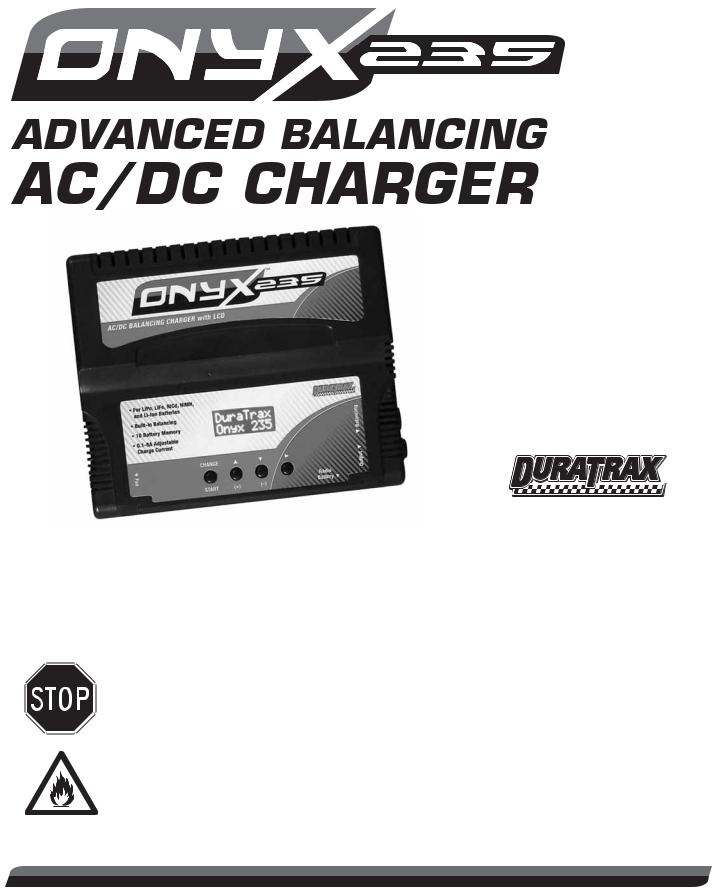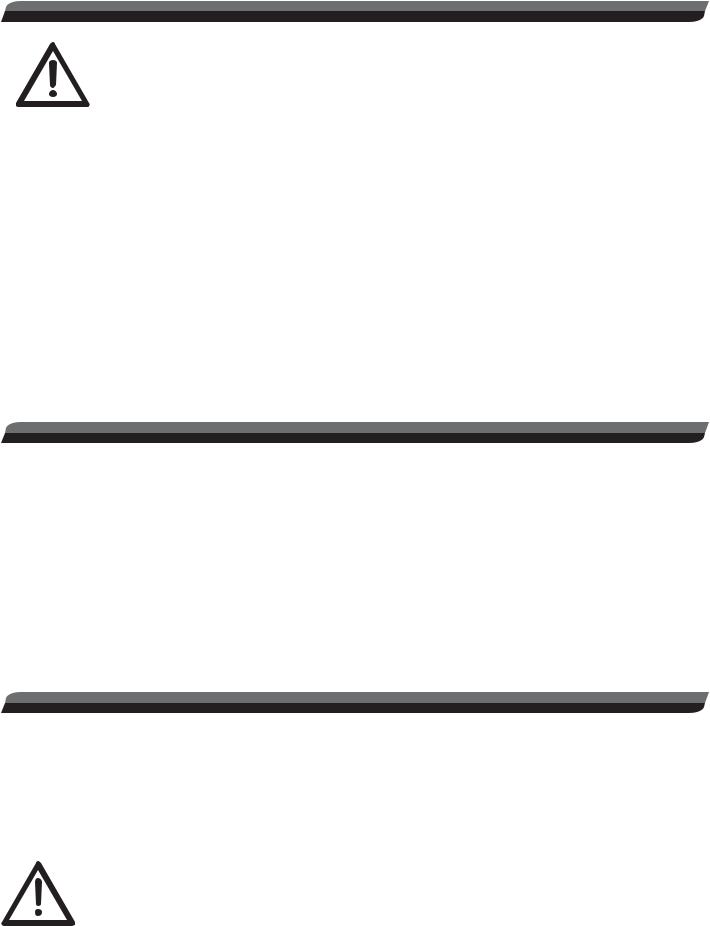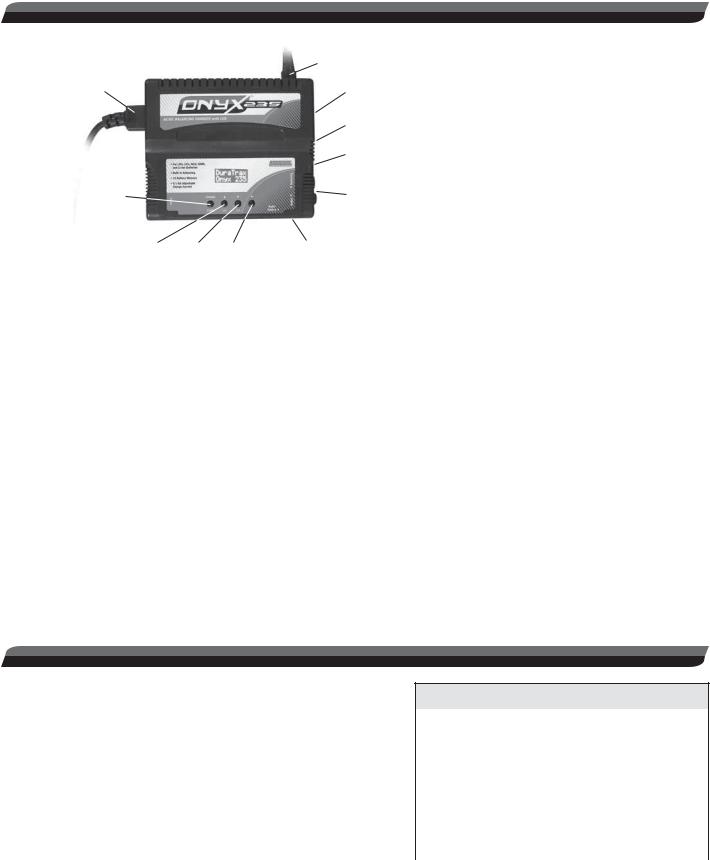Duratrax Onyx 235 Advanced Balancing User Manual

™ |
DTXP4235 |
INSTRUCTION
MANUAL
®
The Onyx 235 charger is great for a huge range of charging and balancing needs for electric on-road, off-road, boat and radio applications! Charge currents up to 8 amps and output voltages for charging up to 10-cell NiMH or 4S LiPo packs make it equally as useful for 1/32 scale micros as large as 1/8 scale electrics, plus nitro receiver packs and transmitter batteries. A built-in balancer optimizes charging of lithium packs, including LiFe cells such as LiFeSource™ brand packs. A built-in jack is perfect for charging radio batteries. A USB jack allows for charging of music players, cell phones, etc. while at the track. AC/DC fl exibility with detachable input cords, reversed backlit LCD, simple controls and menus make it supereasy to use anytime, indoors or out.
It is strongly recommended to completely read this manual before use! Damage resulting from misuse or modification will void your warranty.
WARNING!! Charging lithium-based rechargeable batteries poses a risk of FIRE! NEVER treat lithium-based batteries in the same manner as other battery types. NEVER leave lithium batteries unattended while being charged! ALWAYS charge lithium-based batteries in a fireproof location! Failure to follow all care and handling instructions contained in this manual could result in quick, severe, permanent damage to the batteries and all surroundings!! Follow all safety precautions when using such batteries, as listed on page 3 of this manual!
INDEX
Specifi cations and Features . . . . . . . . . . . . . . . . . . . . . . . 2 Precautions. . . . . . . . . . . . . . . . . . . . . . . . . . . . . . . . . . . . 3 Glossary of Terms. . . . . . . . . . . . . . . . . . . . . . . . . . . . . . . 3 Input Power. . . . . . . . . . . . . . . . . . . . . . . . . . . . . . . . . . . . 3 Controls and Connections . . . . . . . . . . . . . . . . . . . . . . . . 4 Battery Types . . . . . . . . . . . . . . . . . . . . . . . . . . . . . . . . . . 4 Getting Started . . . . . . . . . . . . . . . . . . . . . . . . . . . . . . . . . 5 Adjustable Settings. . . . . . . . . . . . . . . . . . . . . . . . . . . . . . 5 User Setup Screens . . . . . . . . . . . . . . . . . . . . . . . . . . . . . 7
View Data Screens . . . . . . . . . . . . . . . . . . . . . . . . . . . . . . 7
Battery Connections . . . . . . . . . . . . . . . . . . . . . . . . . . . . . 7
Starting Charge . . . . . . . . . . . . . . . . . . . . . . . . . . . . . . . . 8
Charge Complete . . . . . . . . . . . . . . . . . . . . . . . . . . . . . . . 9
Care and Handling of Batteries . . . . . . . . . . . . . . . . . . . 10
Battery Storage . . . . . . . . . . . . . . . . . . . . . . . . . . . . . . . 10
Cooling Fan . . . . . . . . . . . . . . . . . . . . . . . . . . . . . . . . . . 10
Error Messages and Troubleshooting . . . . . . . . . . . . . . . 11

SPECIFICATIONS
AC input: |
110V AC 60Hz – 240V 50Hz, detachable cord, 50W |
DC input: |
11– 15V DC, detachable DC cord with insta-gator clips, 70W |
Battery types: |
1– 10 NiCd or NiMH (1.2 – 12.0V) |
|
1– 4 LiPo, Li-Ion, or LiFe (3.7– 14.8V) |
Battery capacity range: |
50-9900mAh |
Fast charge current: |
0.1– 8.0A linear, adjustable (4C limit for lithiums, 5A limit with AC input) |
Fast charge termination: |
peak detection for NiCd/MH, cc/cv for lithiums |
Fast charge safety timer: |
off - 300 minutes |
NiCd/NiMH Peak sensitivity: |
3 – 20mV adjustable |
NiCd/NiMHTrickle charge current: |
auto (1/20 fast chg setting), or manual adjust (0-250mA) |
Lithium Balancing Accuracy: |
5mV per cell |
Lithium Balancing Socket: |
JST EH |
Included balancing adapters: |
ElectriFly® & FlightPower®/Thunder Power Adapter Board |
Lithium max. node current: |
300mA |
Controls: |
4 pushbuttons |
Battery memories: |
10 |
Display type: |
2 8 reversed LCD with backlight |
Setup tones: |
on /off |
Audible melodies: |
5 |
*Output connections: |
banana jacks, radio jack, regular USB jack for charging mp3 players, |
|
cell phones, etc (5V, 500mA), mini USB for fi rmware updates |
Included output adapters: |
Banana plugs to Standard |
|
Banana plugs to Traxxas® |
|
Banana plugs to Deans® Ultra® Male |
Protective devices: |
solid-state reverse polarity and current overload |
Case size: |
6.3 5.3 1.7” (160 134 43mm) |
Weight: |
18.6 oz. (527.1g w/o cords connected) |
SPECIAL FEATURES |
|
●Detachable AC and DC input power cords.
●Built-in balancing for 1– 4S LiPo, Li-ion, or LiFe (LiFeSource) cells
●Up to 8 amps charge current, and 4C limit for lithiums (5A limit on AC)
●Includes a built-in radio battery jack
●Includes a built-in USB jack for charging music players, cell phones, etc. while at the track
●Includes Banana to Deans Ultra Male, Banana to Traxxas and Banana to Standard charging adapters
●Includes ElectriFly and FlightPower/Thunder Power adapter boards
STANDARD FEATURES
●A tiny built-in switching AC power supply is great for portability and cramped pit areas, yet can still deliver up to 8 amps charge current!
●Fully adjustable charge currents and multi-chemistry adaptability for a wide range of applications.
●A precise cc/cv charge algorithm carefully charges lithium-polymer, lithium-ion, or lithium ferrite-phosphate (A123) batteries fully and safely!
●A peak detection system with automatic trickle charge fi lls NiCd and NiMH packs completely, for optimum battery voltage and run-time. 3-20mV adjustable peak detection helps to customize charger-to-battery performance.
●A reversed LCD with backlight – previously only available in expensive racing chargers – is great for easy viewing in any condition. Shows input and output voltages, peak voltage, charge current, charge capacity and time, and more!
●Pushbutton controls and audible tones make for easy setup and control.
●A built-in fan helps to keep all electronics cool, for long-lasting performance.
●Built-in banana jacks allow for connection with many commonly found charge adapters.
●A detachable DC power lead with alligator clips easily connects to many 12V DC power sources.
●Solid-state reverse polarity and current overload safety devices ensure trouble-free operation and long duration.
2

IMPORTANT PRECAUTIONS
●Disconnect the battery and remove input power from the charger immediately if the charger or battery becomes hot!!
●Do not attempt to charge incompatible types of rechargeable batteries as permanent damage to the battery and charger could result.
●Do not use automotive type battery chargers to power the charger.
●Do not allow water, moisture or foreign objects into the charger.
●Do not block the fan or air intake holes, which could cause the charger to overheat.
●Do not attempt to use batteries with more cells or total voltage than listed in the specifi cations.
●Do not overcharge batteries as permanent damage could result. Do not use a charge current rate which exceeds the safe level of the battery.
●Do not leave the charger unattended while in use.
●Do not place the charger or battery on fl ammable surfaces or near combustible materials while in use, such as a carpet, cluttered workbench, paper, plastic, vinyl, leather, and wood, inside an R/C model or full sized automobile!
●Do not connect the charger to AC and DC inputs at the same time.
●Allow the charger and battery to cool down between charges.
●Always disconnect the charger from the power source when not in use.
GLOSSARY OF TERMS
Amps (A): The unit of measure for charge current.
Milli-amps (mA): A unit of measure for current, being amps (A) multiplied by 1000 and listed as “mA”. So 2.5A is the same as 2500mA (2.5 1000). Or, to convert mA to amps, divide the mA number by 1000. So 25mA is the same as 0.025A (25 divided by 1000).
Capacity and milli-amp hours (mAh): The amount of energy a battery can store is called its capacity, which is defi ned as how much current a battery can supply constantly over one hour of time. Most hobby batteries are rated for capacity in “mAh” or milli-amp hours. A 650mAh battery can deliver 650mA of current for one hour (650mA 1hr = 650mAh). A 3200mAh battery can deliver 3200mA (3.2A) of current for one hour (3200mA 1hr = 3200mAh), etc.
“C” rating: Capacity is also referred to as the “C” rating. Some battery suppliers recommend charge currents based on the battery’s “C” rating. A battery’s “1C” current is the same number as the battery’s rated capacity number, but noted in mA or amps. A 600mAh battery has a 1C current value of 600mA, and a 3C current value of (3 600mA) 1800mA or 1.8A. The 1C current value for a 3200mAh battery would be 3200mA (3.2A), etc.
INPUT POWER
AC Input: For indoor use, this charger includes a built-in switching AC power supply that delivers power by connecting the AC power cord to a common 110V AC outlet.
DC Input: This charger can be powered by a portable 12V DC power source. Located on the rear of the charger is a jack for the connection of the DC power cord. The DC input cord has a keyed plug so reverse polarity can be avoided. Once connected to the charger, connect the DC power cord to the 12V power source. Always match polarities (red lead to red “+” terminal, black lead to black “–” terminal). To utilize the charger’s absolute maximum power capabilities the DC power source must be capable of delivering at least 9 amps while maintaining 12 volts DC.
WARNING! Never accidentally short together the positive (+) and negative (–) input connections when connected to 12V DC power. Failure to do so could result in permanent damage to the power source and the charger.
This charger is rated for a maximum output power of 70 watts. Depending on certain conditions (if charge current is set to maximum, the maximum number of cells are connected to the output, and input voltage is low), the actual current delivered to the battery might be slightly less than the setting. This is normal.
The charger will be on at all times when connected to input power. Disconnect the charger from input power when not in use.
3

|
|
12V DC Input |
CHANGE / START (left): For starting a charge, |
|
|
or to change settings. |
|
110V AC Input |
|
Micro USB |
▲(+): For moving up through menus, or |
|
|
||
|
|
|
increasing the values of settings on-screen. |
|
|
USB |
▼(–): For moving down through menus, or |
|
|
|
|
|
|
Balance |
decreasing the values of settings on-screen. |
|
|
|
|
|
|
Port |
▲: For moving to the right in the menus. |
Change / Start |
|
Output |
OUTPUT BANANA JACKS: For connection |
|
|
Banana |
of any of a wide variety of battery charge |
|
|
Jacks |
leads/adapters. An adapter with standard |
▲(+) ▲(−) |
▲ |
Radio Battery |
connector, Dean’s Ultra connector and Traxxas |
|
|
|
connectors is included. For small electric |
vehicle batteries, fi nd a charge lead that best matches the type of battery you are charging. Look for these and other charge adapters at your local retailer:
ITEM NUMBER |
CHARGE LEAD DESCRIPTION |
DTXC2210 |
Adapter – Standard to Vendetta, MiniQuake, RS4 Battery |
DTXC2225 |
Balancing lead – Banana to 4mm Bullet Adapter 2S LiPo |
GPMM3105 |
Charge lead – banana plugs to BEC connector |
GPMM3149 |
Charge lead – banana plugs to micro connector |
HCAP0101 |
Futaba® J Tx and Rx charge leads |
HCAP0105 |
JR® / Spektrum® TX and Rx charge leads |
HCAP0106 |
Hitec® TX and Rx charge leads |
HCAP0108 |
Charge leads - banana plugs to alligator clips |
HCAP0110 |
9V-style TX connector, Futaba-J Rx charge lead |
Always connect the charge lead to the charger fi rst. Then connect the battery to the charge lead. Always match polarities on the battery wires, charge leads and banana jacks - black connections to black (–), red connections to red (+).
BALANCE PORT: To connect an adapter for balancing of lithium batteries. See page 7– 8.
USB: A 5V/500mA USB jack for charging mp3 players, cell phones, etc.
Micro USB: For updating fi rmware.
Radio Battery: To directly connect a receiver or transmitter battery for charging.
DETERMINING BATTERY TYPE AND SPECIFICATIONS
IMPORTANT: What is your battery’s CHEMISTRY TYPE, RATED CAPACITY, AND RATED VOLTAGE? To avoid causing permanent damage to your battery, carefully read your battery’s label and/or instruction sheet or consult your battery supplier and determine:
1.TYPE: Is the battery a nickel-metal hydride (NiMH), nickelcadmium (NiCd), lithium-polymer (LiPo), lithium-ion (Li-Ion), or lithium-ferrite phosphate (LiFe, such as LiFeSource brand)?
2.RATED CAPACITY: The amount of charge energy the battery can store should be listed on the battery’s label in “mAh” (“milliamp hours”).
3.RATED VOLTAGE: If not printed on the battery’s label, consult your battery supplier or determine the proper pack voltage as follows (refer to the charts at right):
a.NiMH and NiCd: number of cells 1.20.
b.LiPo batteries: number of cells 3.70.
c.Li-Ion batteries: number of cells 3.60.
d.LiFe batteries (LifeSource): number of cells 3.30.
NiCd and NiMH Battery Pack Voltages
|
Number of Cells |
|
|
Nominal Voltage |
|
||
|
4 cells |
|
|
4.8 V |
|
||
|
5 cells |
|
|
6.0 V |
|
||
|
6 cells |
|
|
7.2 V |
|
||
|
7 cells |
|
|
8.4 V |
|
||
|
8 cells |
|
|
9.6 V |
|
||
|
9 cells |
|
|
10.8 V |
|
||
|
10 cells |
|
|
12.0 V |
|
||
|
|
|
|
|
|||
|
|
|
|
|
|||
|
LiPo, Li-Ion and LiFe Pack Voltages |
|
|||||
|
|
|
|
|
|
||
|
Number |
Nominal Voltage |
|
||||
|
of Cells |
LiFe |
|
Li-Ion |
|
LiPo |
|
|
|
|
|
||||
|
|
|
|
|
|
|
|
|
1 cell |
3.3 V |
|
3.6 V |
|
3.7 V |
|
|
2 cells |
6.6 V |
|
7.2 V |
|
7.4 V |
|
|
3 cells |
9.9 V |
|
10.8 V |
|
11.1 V |
|
|
4 cells |
13.2 V |
|
14.4 V |
|
14.8 V |
|
|
|
|
|
|
|
|
|
4
